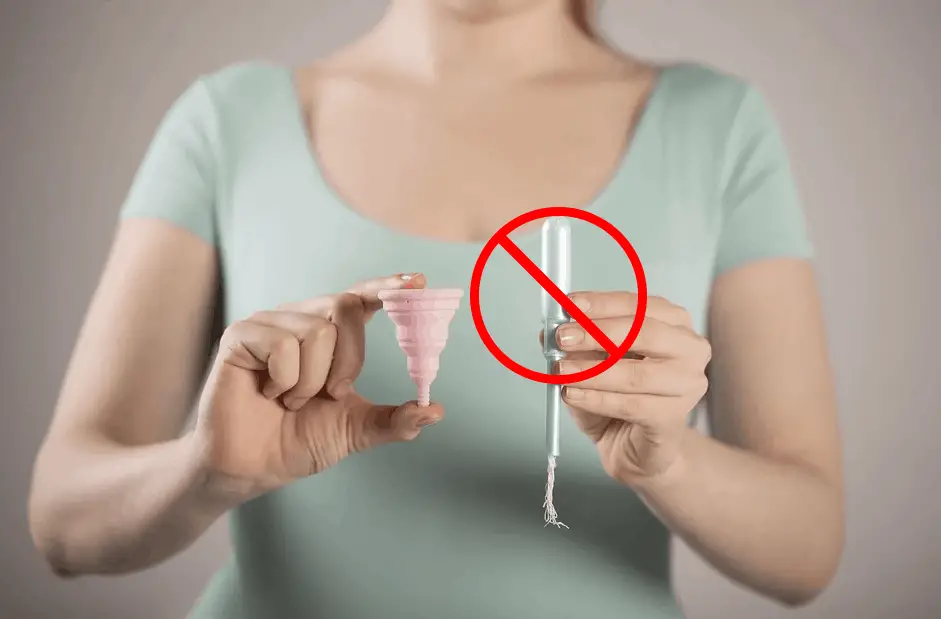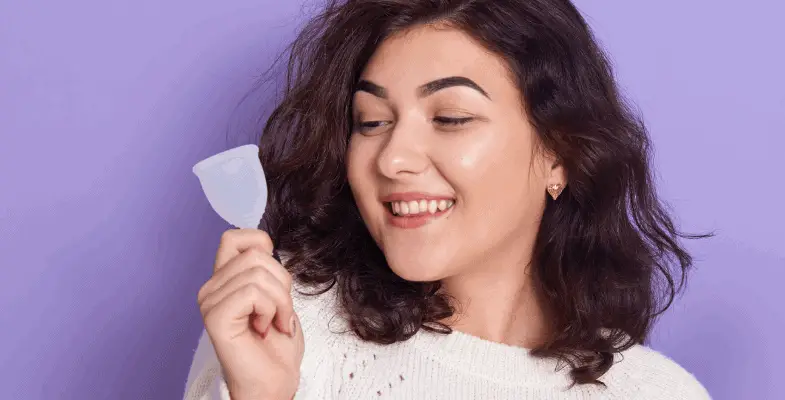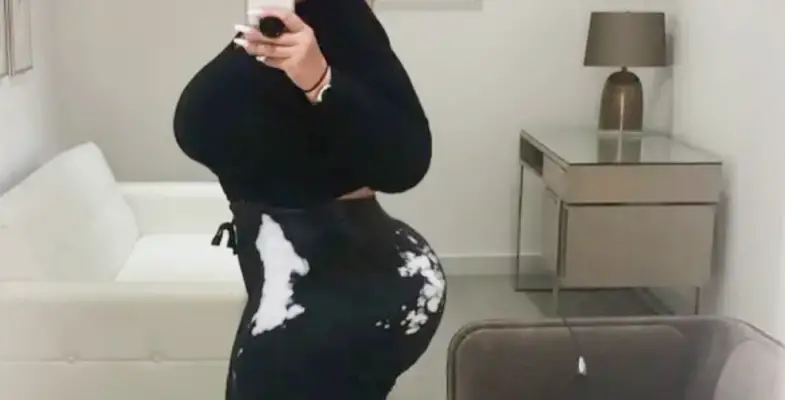As many women do, you may be wondering how you can better manage your flow to ensure a stress-free, leak-free, comfortable, and easy few days while on your period. This time can be the most stressful and annoying time of the month. The aches, cramping, the restricted movement and flexing of your legs, the constant need to check whether your clothes are spotted, or always going to the washroom to check whether your pad or tampon is drenched. These and many more are struggles that a majority of women face time and time again, month in month out. However, this need not be the case, there is a more eco-friendly, hygienic, and ingenious solution to handle this.
Plus size menstrual cups have been advocated as a suitable alternative to pads and tampons. These cups are shaped as small bells with a handle or ‘stem’ of sorts at its lower periphery. Menstrual cups usually work to collect fluid from the vaginal wall as opposed to soak or absorb it. The bell-like end serves as an airtight seal that sits at the very end of the cervix.
This seal allows it to ‘lock and hold’ itself at the cervix thus sitting in place for the entire duration of time needed, without shifting or dislodging. The stem allows you to insert and remove the device. Most menstrual cups are translucent in color though there are those with more flamboyant colors such as shades of pink, red, purple, and also discreet black.

How Menstrual Cups work
These cups are designed to sit inside your body and are positioned at the very end of the cervix. Their purpose is to hold any blood or clots from the uterine wall as soon as they exit the cervix. That way blood does not need to run down your vagina and out of your vulva.
Menstrual cups work by sitting in place once inserted into the vagina and once full, they can be easily removed and the fluid poured out. They are designed to be flexible and soft to aid in insertion and minimize any abrasion and discomfort during insertion and removal. They are also washable; meaning that once you pour out the fluid you can give your cup a quick rinse and insert it back.
How to Insert
Insertion is not as painful or sturdy as it may seem to be. You do not need to have a high degree of prowess to successfully insert the same. Even teenagers can be able to do it by themselves. With your menstrual cup at hand, follow these few steps every time for guaranteed successful and pain-free insertion.
- Spread your legs and bend into a mild squat position, just as you would when peeing at a restroom.
- Fold the menstrual cup for easier insertion. The type of fold may depend on the manufacturer’s instructions but a large majority of menstrual cups would need you to pinch the stem and bell part together.
- Insert the cup, making sure to do it gently as possible. Do not force the cup in as this may cause some friction within your vagina. Ensure you are relaxed.
- Push the cup into your vagina and once inside, a considerable way up,
- Release the pinch. The bell-shaped cup should pop open and form an airtight seal at the cervix.
- Use an applicator instead of your fingers, if your hands are extremely shaky or if uncertain whether you can place it correctly.
To ensure it is well placed, try to walk around if there is any pain and incessant discomfort, it may be an indication that the cup is not well-positioned. Gently remove it and re-insert it.
How to Remove
Depending on the capacity of the cup and the heaviness of your flow, your menstrual cup can be removed and emptied after every 4-12 hours. Here’s how to:
- Spread your legs and gently insert your fingers into your vagina.
- Pinch the stem of the menstrual cup – this will automatically release the airtight seal at the cervix
- Gently pull out the cup using the stem.
- Pour out the fluid into the restroom sink or toilet and flush.
Be cautious not to tip the cup over when you remove it from your body as this may cause a mess. After this, proceed to clean your menstrual cup.
How to Clean
Menstrual cups can either be disposable or reusable. If your cup is disposable, this step is not necessary as you simply have to discard it once you pour out its contents. For those that are reusable, this step is of paramount health and hygiene importance.
- Rinse out the empty menstrual cup with plenty of water. Preferably use running water as opposed to stagnant water, if possible.
- Thoroughly dry the cup using a piece of tissue, a cloth (specifically for this purpose) or even wet wipes – non-scented and hypoallergenic.
- Re-insert the cup when completely dry, if you are still on your period.
Depending on the manufacturer’s directions, you can wash the cup with mild soap and a piece of cloth (that you carry specifically for this purpose). Some menstrual cup kits come with a mild wash spray that is to be used while cleaning the cup. In this case use the soap, gel or spray according to the instructions given and rinse the cup with plenty of water (if applicable).
After every month, once done with your cycle you should boil the cup in hot water for a few minutes. This way all harmful bacteria that may have begun to build in the cup while on your flow are destroyed.
Advisably, always ensure that you are in a private and comfortable place as you insert, remove and clean the cup. Also, don’t be in a rush as this may lead to incorrect placement leading to leaks, spills while removal, bad odour or at worst a conducive environment that promotes bacterial infection if the cup is not properly cleaned.
Benefits of Menstrual Cups over Other Menstrual Management Options
Unlike the average tampon or sanitary towels, menstrual cups have numerous benefits such as:
- Greater capacity – an average-sized cup can hold up to 3 times as much as a tampon. The larger menstrual cups can hold nearly 4 times as much as a super-absorbent tampon. leading to fewer visits to the restroom.
- Eco-friendly – their average lifespan is 3-10years, depending on the make. This translates to fewer pieces being used and thus lowering the amount of wastage.
- Leakproof – the cup remains in position inside your body thus no leaks can ensue unless the cup is not well positioned
- No stains on your favourite underwear and no need for back up panty liners or sanitary pads
- No dryness in the vaginal like tampons may tend to do
- Waterproof – you can engage in your favourite water sport such as surfing, swimming all day any day.
- Non-abrasive
5 Common Questions about Menstrual Cups
1. Who can use menstrual cups?
Any woman, young or old, on her period can use a menstrual cup.
2. Can a virgin use a menstrual cup?
Absolutely yes. The cup sits at the foot of the cervix and does not penetrate you any further.
3. Can I have penetrative sex while wearing a menstrual cup?
Yes, yet again! The cup being internal can hardly be felt by your partner. However, if you want to take advantage of this, pick menstrual cups that are designed with sex in mind.
4. Can I have a high-intensity work out with a menstrual cup on?
Yes, not only can you have a good work out, but you probably won’t notice that’s even there. The cup is designed to sit in place and thus can not easily be dislodged during a workout session.
5. How safe are menstrual cups?
Several studies have been conducted on several groups of women to ascertain the safety of menstrual cups. The findings show that there is a lower prevalence of bacterial infection and other STIs among women who use them compared to those that use tampons and other sanitary devices.
This is because the cups are manufactured using materials that do not disrupt your body hormonal and mineral equilibrium. Therefore, the naturally occurring bacteria ‘good bacteria’ found along your vaginal wall are not disturbed. Additionally, the cup does not absorb the fluid but merely collects it. This offsets the possibility of ‘drying out’ any naturally occurring moisture on the cervical wall and vagina. The moisture is useful for the healthy maintenance and performance of the cervix, vagina and other incidental parts.
How to Know Your Menstrual Cup Size
Commonly menstrual cups are sized based on the capacity of fluid they hold. They typically come in 2 sizes a small and large size. The smaller sizes hold less fluid as compare to the larger ones. However, with recent developments, manufacturers factor in other features in sizing their menstrual cups.
Unique Features to consider
Not every sexual anatomy is shaped the same way, there are unique features that ought to be taken into account as they are determinative of the kind of menstrual cup you should purchase. Other than the heaviness or lightness of your flow, these additional features should also be borne in mind when it comes to selecting the right size. They include:
- Low cervixes – these will mandate shorter menstrual cups
- Tilted cervixes – this will also mandate shorter menstrual cups
- Stronger pelvic muscles – this may be as a result of extensive workouts and training. It is advisable to have smaller menstrual cups for less discomfort. Alternatively, a super soft and flexible one that reduces discomfort.
- Wider vaginas – this may be because of childbirth. Such ladies should consider purchasing larger menstrual cups
- Long vaginas – this will mandate the use of a longer menstrual cup so that insertion will be easier.
- Age – ladies below the age of 18 can opt for a small-sized menstrual cup, whereas ladies who have given birth can opt for the larger menstrual cups.
What to Look For In A Plus Size Menstrual Cup
For the best experience in using a menstrual cup, here are some vital features you should look for
- Fit – this is determined by the unique anatomy of your reproductive system. However, one’s flow should be taken into account. Where no unique features are present the general rule is that younger girls should opt for smaller cups as they will fit better. Older women should opt for larger cups because their cervix and vaginas are expanded due to childbirth.
- Extra soft – this reduces any discomfort or abrasion caused by the presence of the menstrual cup especially during insertion and removal
- Flexibility – a super flexible cup will be easier to insert and remove.
- Hypoallergenic – essentially nonirritant or nontoxic. You can opt for one that is not bleached or containing any form of plastic.
- Cost-efficient – value packs can be quite helpful especially if you are looking to spend less. Most value packs come with two menstrual cups, which will have you not return to the counter to purchase a menstrual cup for another 6-20 years!
Tip: Instead of purchasing a standard pack consider purchasing a variety pack – this way you will have cups of the same fit but with varying capacities. On your heavier days, you can opt to use those of wider capacities and on your lighter days, those of smaller capacities.
Here Are Some Menstrual Cups That May Consider
- Diva Cup – comes in either pre and post-childbirth kits. It is made up of 100% health care silicone.
- Pixie Menstrual Cup Starter kit – a formidable value pack that comes with 2 menstrual cups (large and small sizes), a wash, lube, wipes, and sterilizing container.
- Flex Menstrual Cup – has a unique pull string design for mess-free and easy removal.
Final Thoughts
Hesitant? If you are still unsure about menstrual cups, why not give it a try when your period is lighter. This way you can mitigate the risk of any leaks, spills, or stains. With menstrual cups, you can lead a normal life and engage in all your favorite activities all year round. You don’t have to quit anything. Be safe, have fun, enjoy a stress-free menstrual cycle, and be sure to check out some of our top picks.



